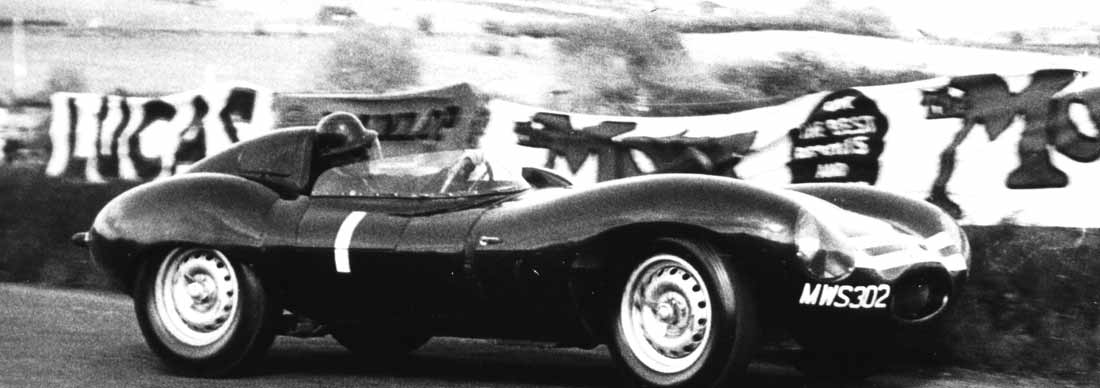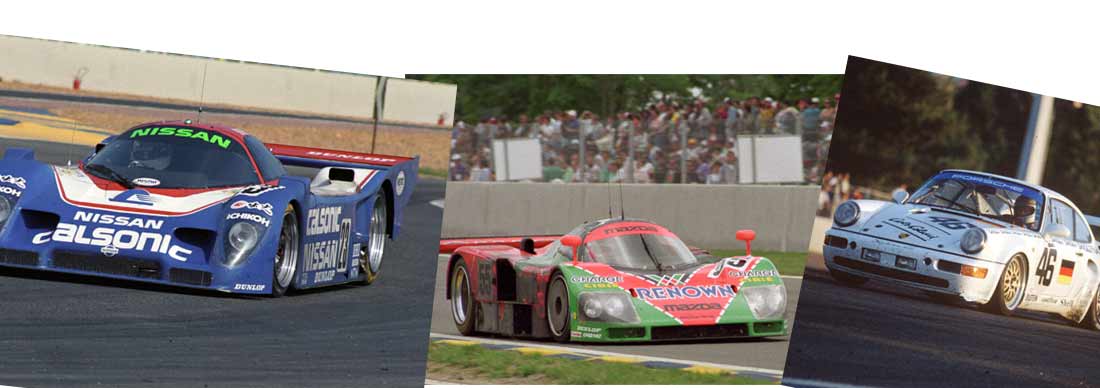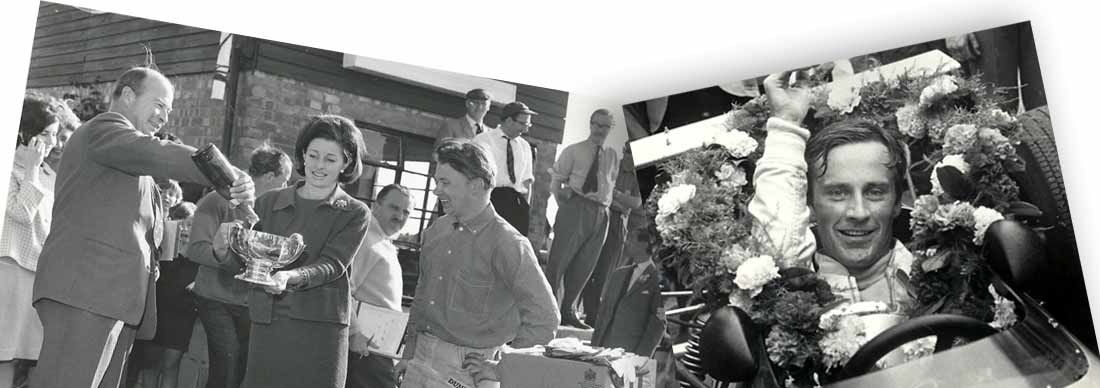
Ron Gaudion, Jaguar Works and Ecurie Ecosse mechanic
Interview by Philip Porter
On a trip to Australia in 1996, I visited Ron Gaudion and we have been good friends ever since. Ron worked for Jaguar and then Ecurie Ecosse in the great days and has a fund of fascinating tales.
As a child Ron helped his father maintain his car and, when he began working as a toolmaker, needed a car of his own. He and his brother invested £75 in an Austin Seven chassis and built up a usable car from this basis. As a result, his enthusiasm for cars was fired.
After a year of travelling and working his passage around Australia when he and a couple of friends covered 17,000 miles, of which just 4,000 were on metalled roads and the rest were dirt tracks, the young Gaudion felt he needed to broaden his engineering experience and decided to travel to Europe in 1953.
For 10 months he worked in the Experimental Department at a company in Manchester involved in aircraft work. Seeking automotive experience, Ron decided to move to Coventry in 1954.
‘So I visited Standard Cars, Alvis, Norton, Triumph, Jaguar and all these places but no-one had any work.’
Determined to find something, he went to the government employment service. They gave him a couple of names but these were not what Ron was looking for and so he went back again. They looked again and said they had just heard Jaguar were recruiting 40 people. They gave him an introduction and sent him along.
‘I went to the Personnel Manager and he said, “Not you again! I told you the other day, there’s no jobs.” I showed him my paperwork. “Oh God,” he said. “I forgot all about that. That’s a special project. Go and see Tyrrell Smith.”
‘Tyrrell Smith was the foreman of this new department which was attached to the Experimental Dept, which was attached to the Competition shop.’ Finding they had a common interest in speedway riding, the two immediately hit it off.
‘He said, “When can you start?”
‘I said, “Hang on. What’s the job?”’
Smith explained they were starting a section to build 100 new sports cars and needed tool fitters, welders, etc.
‘“When can you start,” he asked.
‘This was Tuesday. I said, “Next Monday.”
‘He said, “What’s wrong with tomorrow?”’
That was how Ron joined Jaguar. The project was to make the chassis frames for the Long Nose D-types initially and the templates that would be used to make the Production D-types that would follow.

‘The first three chassis went into the Comp. Shop next door. They wanted the Works three, plus one for Briggs Cunningham, one for the Belgian team and one for the French. So that was six and there were only about five blokes in the Comp. Shop at that time. So Phil Weaver, who ran the Comp. Shop, had a word with me.
‘“Look Ron,” he said, “we’re a bit pushed for time. Would you like to come in and help finish one off?” He told me to pick one of the boys and so I chose Roy Cole, who would later be my Best Man.
‘We’d been working on these things for months and could put them together pretty quickly. Len Hayden, Bob Penney and the others in the Comp. Shop were working on theirs and there was still one more to do. So I asked Phil if we could do that one as well and he said, “Go for your life!” So we ended up doing two.
‘Halfway through this – it would be about May – Phil said, “Do you have a passport? We’re one short for Le Mans.” Of course I was keen to go but worried I would need a visa to get into France.
‘So they contacted Mr. Lyons and arranged for his chauffeur with his Mark VII to take me to Birmingham to the French Consulate to get a visa.
‘So I went to the 1955 Le Mans which was really great.’

Gaudion has a splendid Duncan Hamilton anecdote about the start.
‘It was the traditional Le Mans start and with about three minutes to go the drivers were starting to wander across to the other side of the track. Old Duncan wanted to be the last across.
‘All the cars had two latches – first and second latch – on the doors. So they would open the door and just leave it sitting there so that, when they ran across, they just flipped the door and jumped in.
‘Next to Duncan, I think it was Peter Collins in a Ferrari. Obviously everybody wanted to get a good start and it was not easy with the narrow track. So, as Duncan went across, he walked behind the Ferrari and just nudged the door with his elbow and put it on the first latch!
‘The flag dropped. They ran across. Peter Collins went to flick the door open and it wouldn’t. By the time he had taken a second or two to work out what was going on and put his hand in to open it, Dunc was away!’
Ron recalls that, after problems in practice, Hawthorn’s car was fitted with a new engine.
‘While he was racing with Fangio, that engine had used about a gallon, gallon and a half of oil by the first pitstop. But it bedded itself in under racing conditions. By the end of the race, it was not using any!
‘I got back [to Jaguar] and Tyrrell Smith told us we’d got to set up a line between the Mark VIIs and the 140s to produce the remaining 90 or whatever, D-types. So I was working on this and round about July Les Bottrill* told me he’d been offered a couple of jobs – one in North America and one with Ecurie Ecosse.

‘So I said, “Who’s Ecurie Ecosse?"
‘“They’re a Scottish team,” he said, “They’ve been racing C-types and they’re buying three of the D-types, and they need somebody. I’m going to take the Yankee job, why don’t you apply for the other one?’
‘I decided I was interested because I wasn’t permanently on the Comp. Shop staff and, even if I had been, they only did three races a year. If you wanted an engine, you just plucked an engine and put it in. If you wanted a gearbox, the same – you have an engine man, a gearbox man, a diff man… I wanted to be able to do all that myself. With a private team with three cars and 15 races a year, that’s 45 cars to prepare for two guys – Sam Sproat and myself. I thought I was going to learn something.

Ron saw ‘Wilkie’ Wilkinson, the Chief Mechanic at Ecurie Ecosse, when Wilkinson visited the Jaguar works a few days later to collect the new cars and ‘Wilkie’ suggested that Ron went to the next meeting at Aintree to meet David Murray, the team chief.
‘I was on £18 a week, with overtime, at Jag. David Murray said he would give me £8 5s [£8.25].
‘I said, “Oh thanks very much. You’re generous for a Scotsman!”
‘“The best I can do,” he said, “is £10. My best man is on £10.” I later found out ‘Wilkie’ was only getting £12. So I went up in the August and got the cars ready for the next season.
‘They wanted to do some engine lightening work on the overhead gear, which the works didn’t do. So I learnt a lot. We used to get a few more revs out of the cars. The works said 5,800 was max, whereas we could go to 6,200.

‘In ’56 I picked up the D-type to drive with the Works cars to southern England to fly across en route to Le Mans. I was number six in line and I didn’t know where we were going. We were doing about 60mph through the country roads and a farmer pulled out in front of me with a tractor and hay trailer. The others just disappeared. I knew I had to catch them as I hadn’t a clue where I was going.
‘That was the quickest I ever went in a D-type. I got up to about 160mph and fortunately I caught them!.
‘We generally had very little trouble with the cars – the odd gearbox problem. Even the blocks were standard. We never even honed them, even from one season to the next. Our engines never did a crankshaft, never threw a rod. We just put in new rings and bearings, but there was no wear to speak of at all. Very good.
‘Changing back axles was a bit of a hassle. It used to take two of us five hours just to change a ratio. All the brakes had to be set up again, lap the hubs into the shafts, that sort of thing.
Ron has a fund of stories about the drivers and other characters. For him, the best Jaguar driver was Mike Hawthorn, who seems to have been universally popular with all the people I have ever interviewed.

Ron has a splendid way of debunking widely held views on other drivers and one or two people he worked with. Some of them, regrettably, are unprintable at present!
‘God, were the drivers fussy about the height of the windscreens! Flockhart was taller than Sanderson, so Sanderson had a very thin seat squab. Another interesting fellow who raced for us was Archie Scott-Brown. He had a nine-inch squab – the wheel was really close to him – and sat on a four-inch cushion.
‘At Aintree we’d fitted a new screen and before practice Ninian Sanderson sat in the car and said, “Needs an inch off the top of the screen. The pedals need to be bent a bit this way.” David Murray told us to go and fix it.
‘We went away and brought it back next morning.
‘“How’s the car, Ninian?”
‘“Spot on, boys, spot on. Thanks very much.” We hadn’t touched it. Put four newspapers under the seat!
‘Jimmy Clark and Jackie Stewart used to come and visit Merchiston Mews [the Ecurie Ecosse garage] as schoolboys.’
Great times, great memories. I am delighted to report that Ron is still going strong and he and his lovely wife, May, came over as guests at the 2017 Goodwood Revival meeting which celebrated 60 years since Ecurie Ecosse second Le Mans win in 1957. Sir Jackie was there and paid the tribute to Ron, the last remaining Ecurie Ecosse mechanic from that wonderful period.






1 comment
I now live in northern New Hampshire in the US but grew up in Edinburgh, Scotland. On many Sundays in the early 1960s my dad and I would visit my granny who lived closer to the city center at 10 Bryson Road. Several times dad cycled his single speed Hercules bike with me on a seat mounted to the top tube – we didn’t own a “real” car, just a temperamental three-wheeled Bond mini-car. On the way, we would stop at the Ecurie Ecosse garage at Merchiston Mews so that I could look at the race cars. My 2002 Jaguar proudly wears its “ECURIE” license plate.
Mark Russell
Leave a comment
This site is protected by hCaptcha and the hCaptcha Privacy Policy and Terms of Service apply.